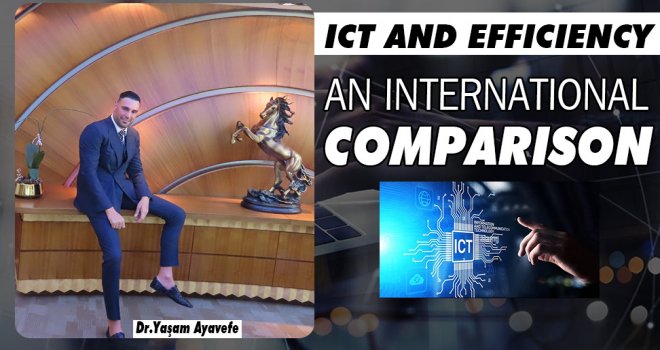

ICT AND EFFICIENCY - AN INTERNATIONAL COMPARISON

ICT AND EFFICIENCY
AN INTERNATIONAL COMPARISON
In 2001, there was a breaking point in American analyzes of information and communication technologies (ICT) and their impact on productivity gains within the framework of growth accounting.
By then, the simultaneous increase in ICT investments and total factor productivity (TFP) clearly demonstrated the existence of a causal relationship.
After this date, the perception of this connection has changed. Because after the bursting of the technology bubble, there was a great decrease in ICT investments. Despite this, the gains in TFV continued to be sustained in the 2001-2003 period.
In Europe, the discussion has largely focused on the lag compared to the United States in terms of investment and productivity gains in ICT between 1995-2001.
A debate arose over the source of the productivity gains. For some, these gains are largely concentrated in the consumer durables sector.
It finds a spread of productivity gains in the ICT-using industry, particularly in the trade and financial industries. These conflicting results from the same investment data highlight the difficulty of measuring hourly productivity growth and its various factors. Growth accounting provides a useful framework for examining the evolution of productivity.
Now let's look at the assessments made in this context for France, the United States, the United Kingdom, and Germany.
There are evaluation differences due to methodological differences between studies.
In particular, a measure of contributions to the growth of hourly productivity at the macroeconomic level has been proposed. Then, a detailed analysis is proposed for the sectors that produce and use ICT.
Few sectoral assessments have been made so far. The methodological problems are more acute as they are at the level of the economy as a whole. This makes comparisons difficult. However, sector analysis is interesting to us.
On the one hand, it makes it possible to embody the contribution of ICT to productivity gains. On the other hand, it is necessary to better assess how far these gains have spread beyond just the manufacturing sector.

Answering this question makes it possible to better predict the potential impact of these new technologies on the entire economy.
CONTRIBUTIONS TO INCREASING HOURHOUR WORKER PRODUCTIVITY
Described as generic technologies, ICTs are often compared to a third industrial revolution. They produce productivity gains that can improve the standard of living of countries likely to increase their growth potential.
However, some are skeptical about the ability of ICTs to produce major innovations that cause technological change.
These observations are made from the American example of the second half of the 1990s, when the strong contribution of ICT was associated with the acceleration of productivity growth.
Based on the Solow model, the growth accounting framework makes it possible to distinguish three main sources of growth in hourly labor productivity: increase in capital intensity (capital services by hours worked), increase in quality of work (labor services), and gains in overall factor productivity.

Within capital, more specifically the contribution from the use of ICT capital can be defined separately.
what is ict
impact of information technology on productivity
impact of ict on education
impact of ict on education pdf
impact of ict on business
impact of technology on education
what are five latest inventions of computers
Current analyzes
Between 1995 and 2001, hourly labor productivity gains in the United States averaged between 2% and 3%.
Europe seemed to follow the same dynamic as the United States. However, there is a delay that it has not been able to make up for so far. Compared to the previous five years, primarily hourly productivity and total factor productivity did not accelerate, on the contrary, they slowed down.
Later, the contribution of ICT capital intensity to hourly productivity growth also increased. This increase is much smaller than that observed in the United States.
Various reasons have been put forward to explain why Europe lags behind the United States in using ICT and accelerating TFP: a set of regulations that would delay ICT adoption in Europe, a complementary effort to reorganize work, etc.
Yaşam Ayavefe
-
 İngiliz donanmasına ait gemi Gazze yardımlarına katkıda bulunacak
İngiliz donanmasına ait gemi Gazze yardımlarına katkıda bulunacak
-
 Dünya Bankası'ndan Türkiye için enflasyon tahmini
Dünya Bankası'ndan Türkiye için enflasyon tahmini
-
 Avrupa seçimlere hazırlanıyor
Avrupa seçimlere hazırlanıyor
-
 Dimitriu, Azerbaycan’a KKTC ile parlamentolar arası iş birliği niyeti yüzünden p..
Dimitriu, Azerbaycan’a KKTC ile parlamentolar arası iş birliği niyeti yüzünden p..
-
 Ege Denizi'nde 4,5 büyüklüğünde deprem
Ege Denizi'nde 4,5 büyüklüğünde deprem
-
 Misilleme alarmı! Her an düğmeye basabilir
Misilleme alarmı! Her an düğmeye basabilir
-
 Bugün yer yer sağanak bekleniyor… Önümüzdeki günlerde sıcaklık 31 dereceye kadar..
Bugün yer yer sağanak bekleniyor… Önümüzdeki günlerde sıcaklık 31 dereceye kadar..












